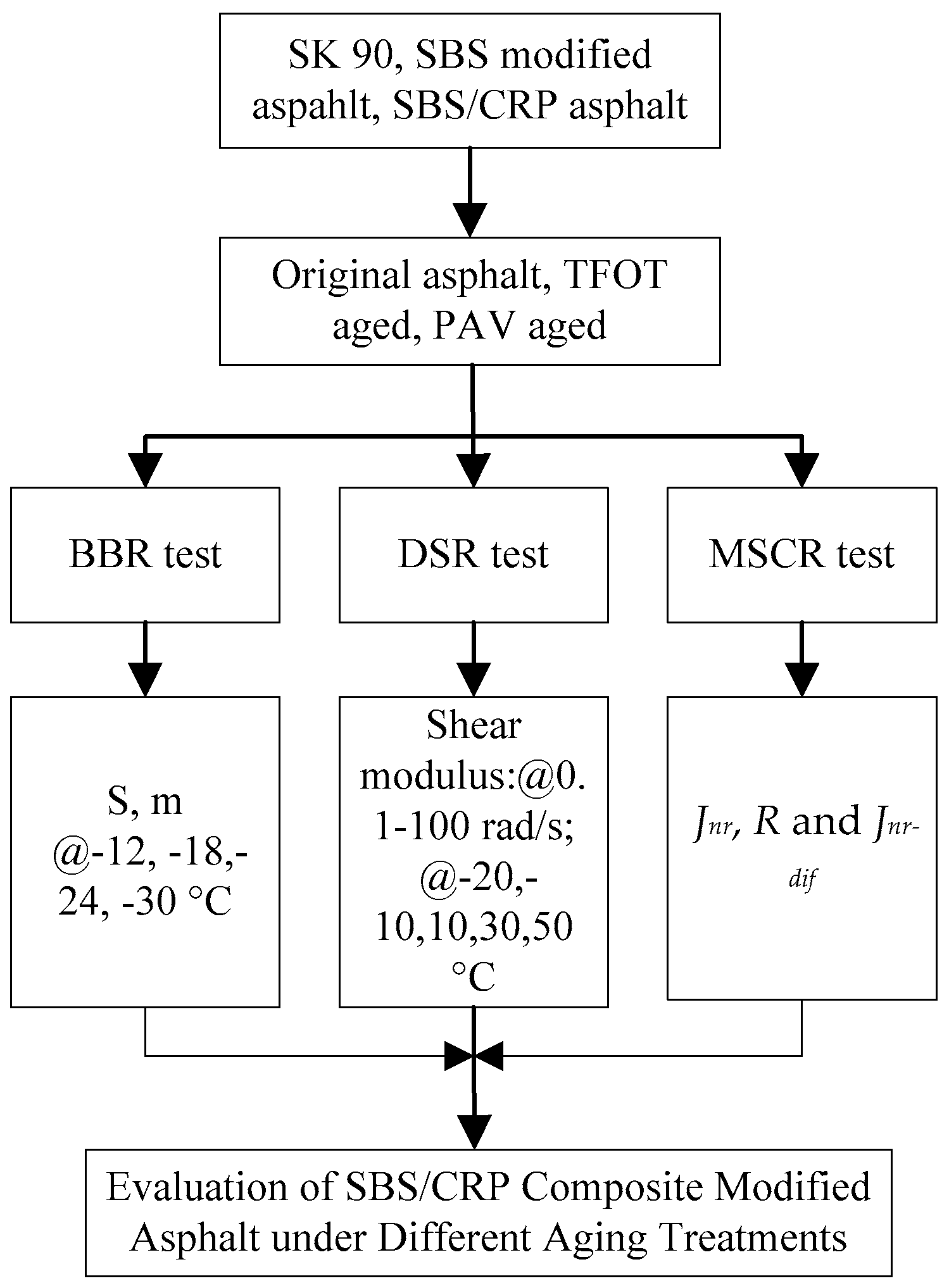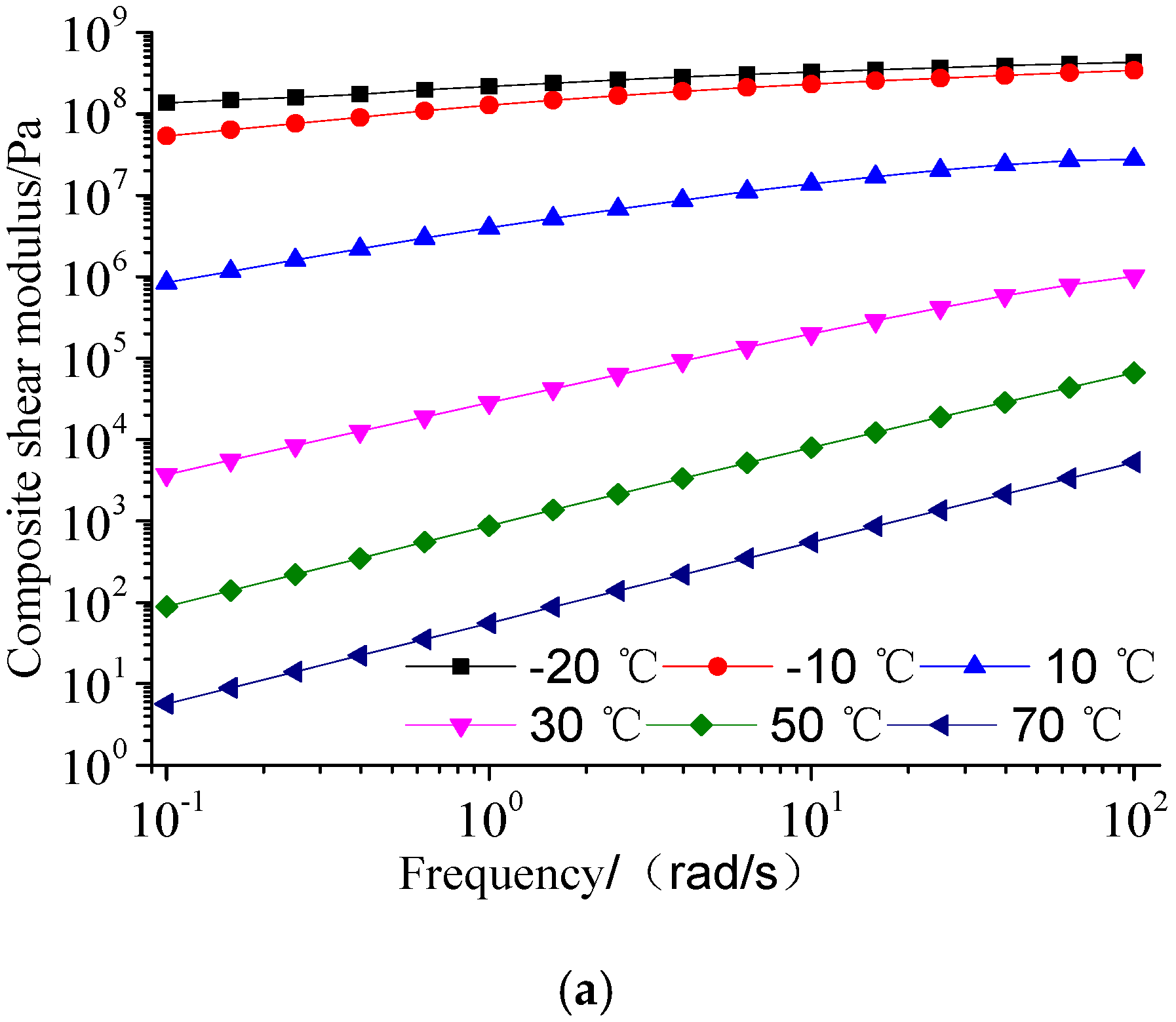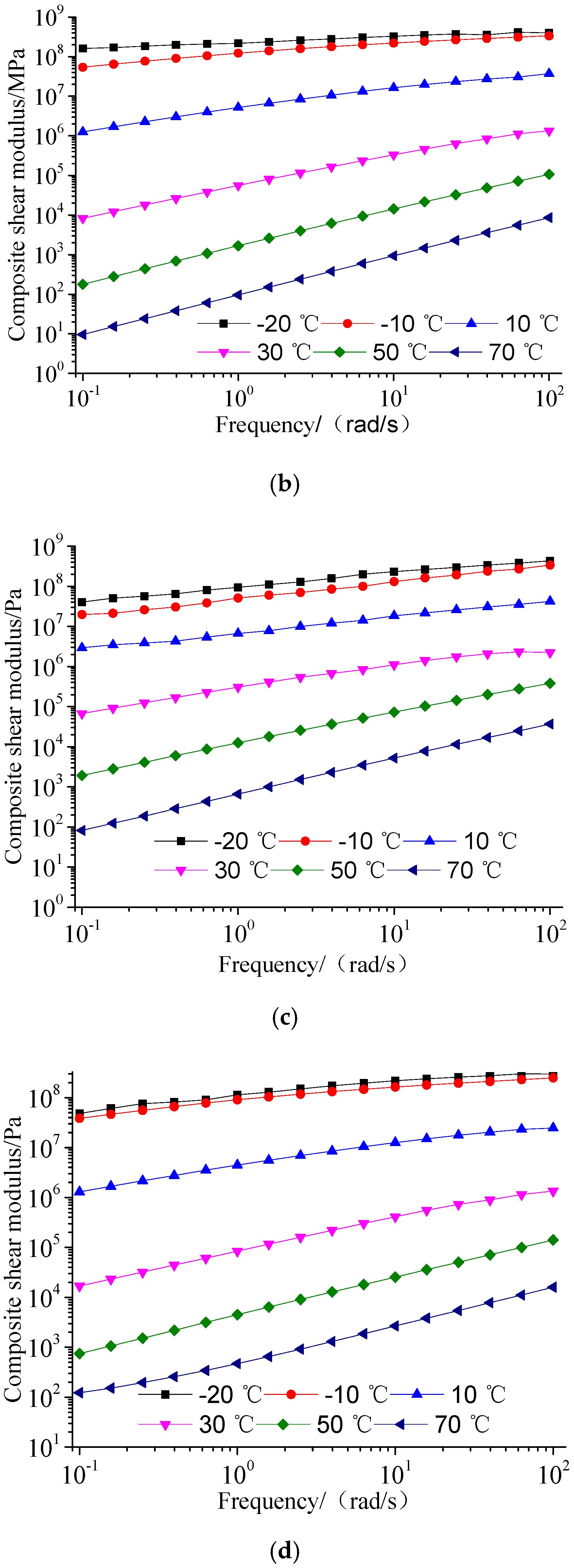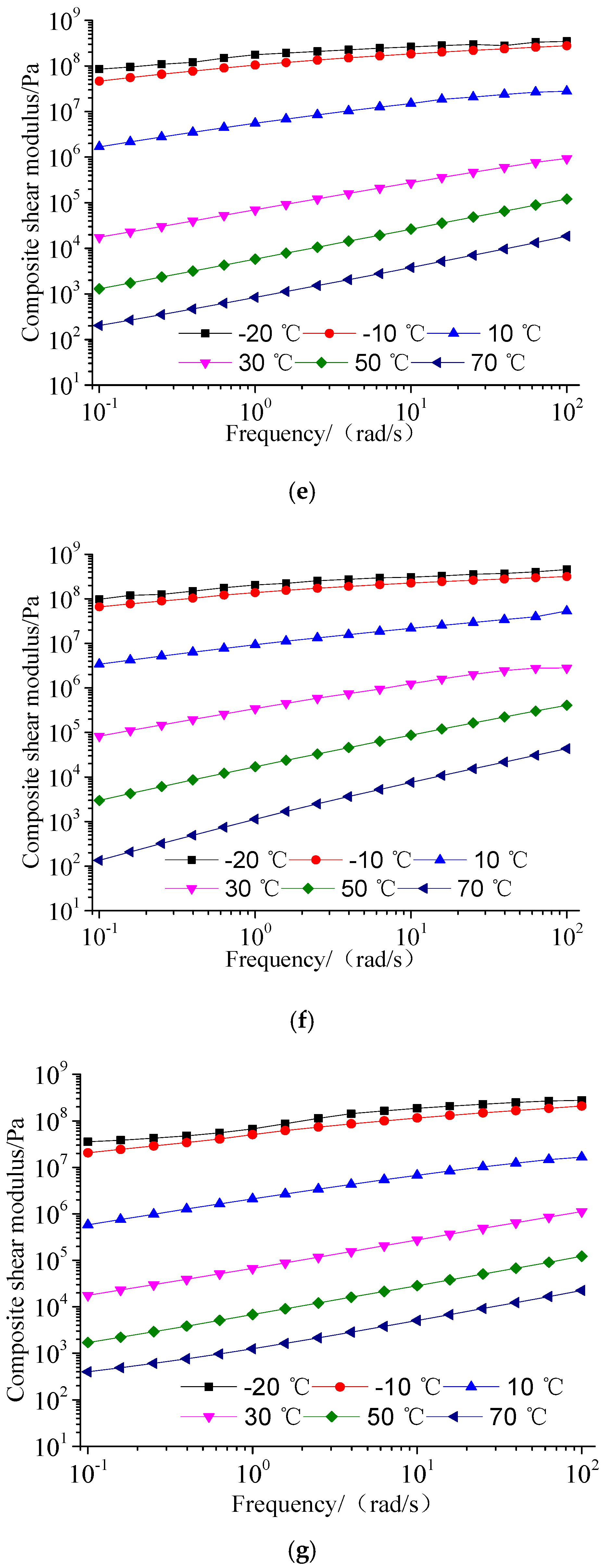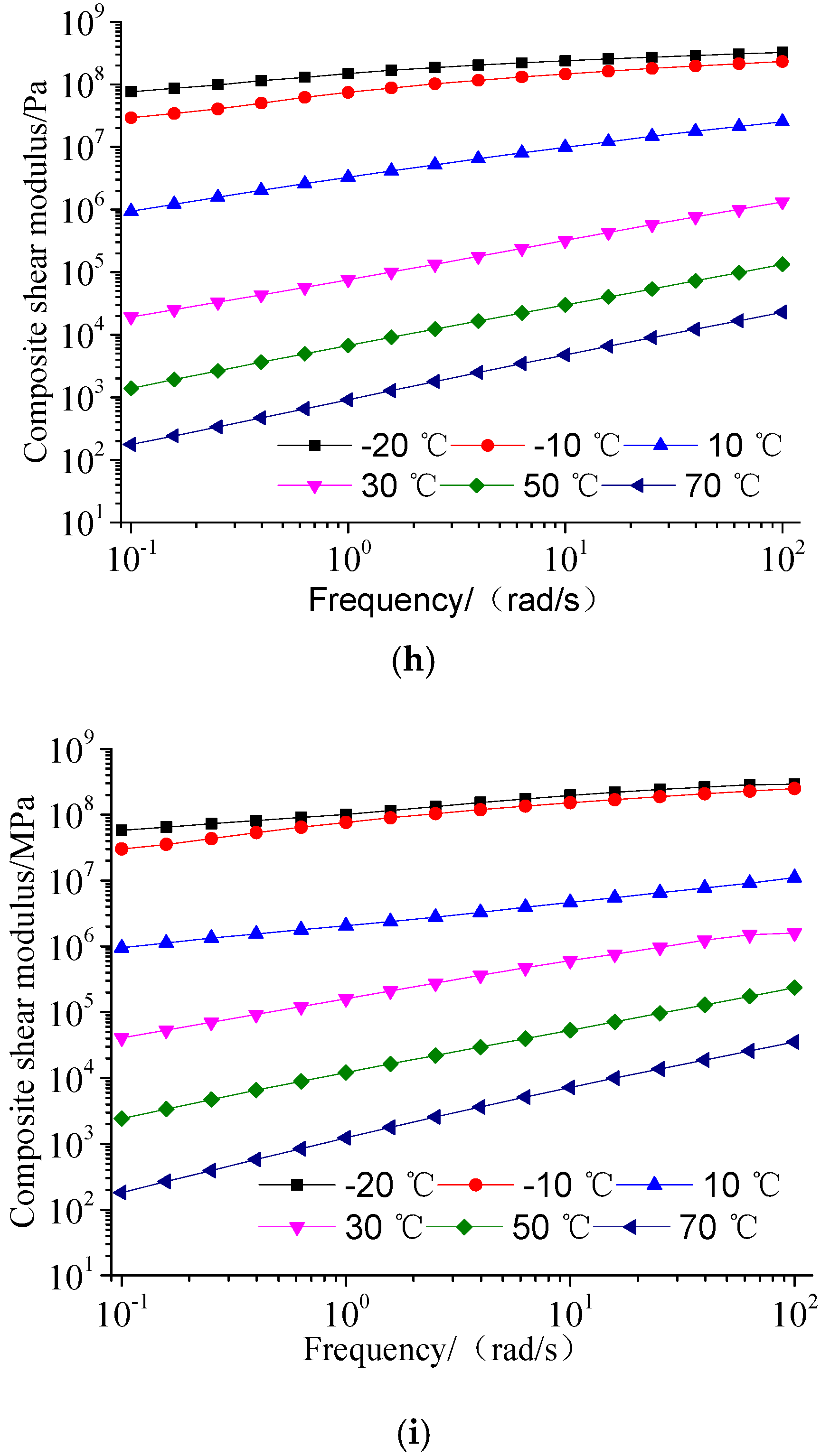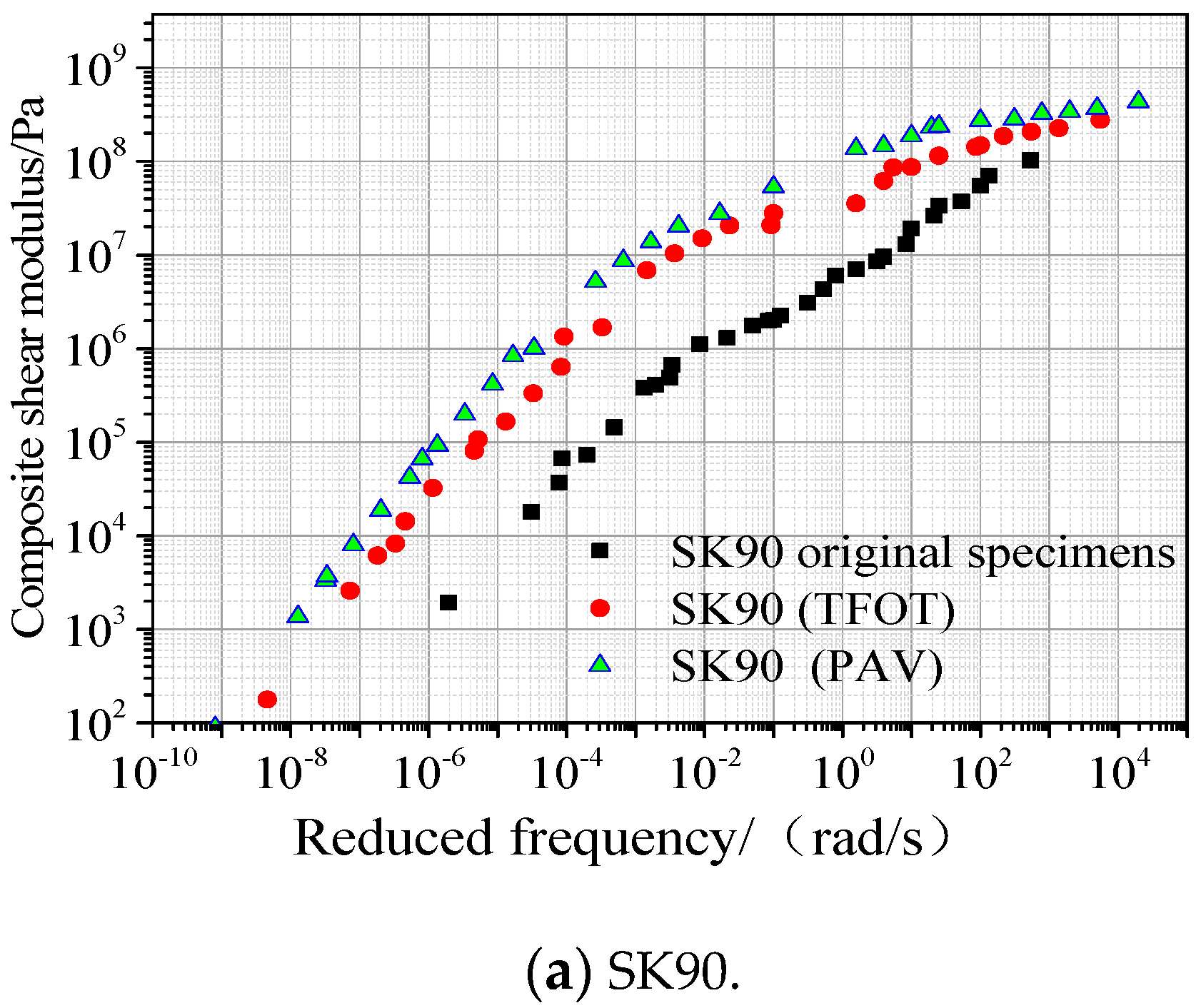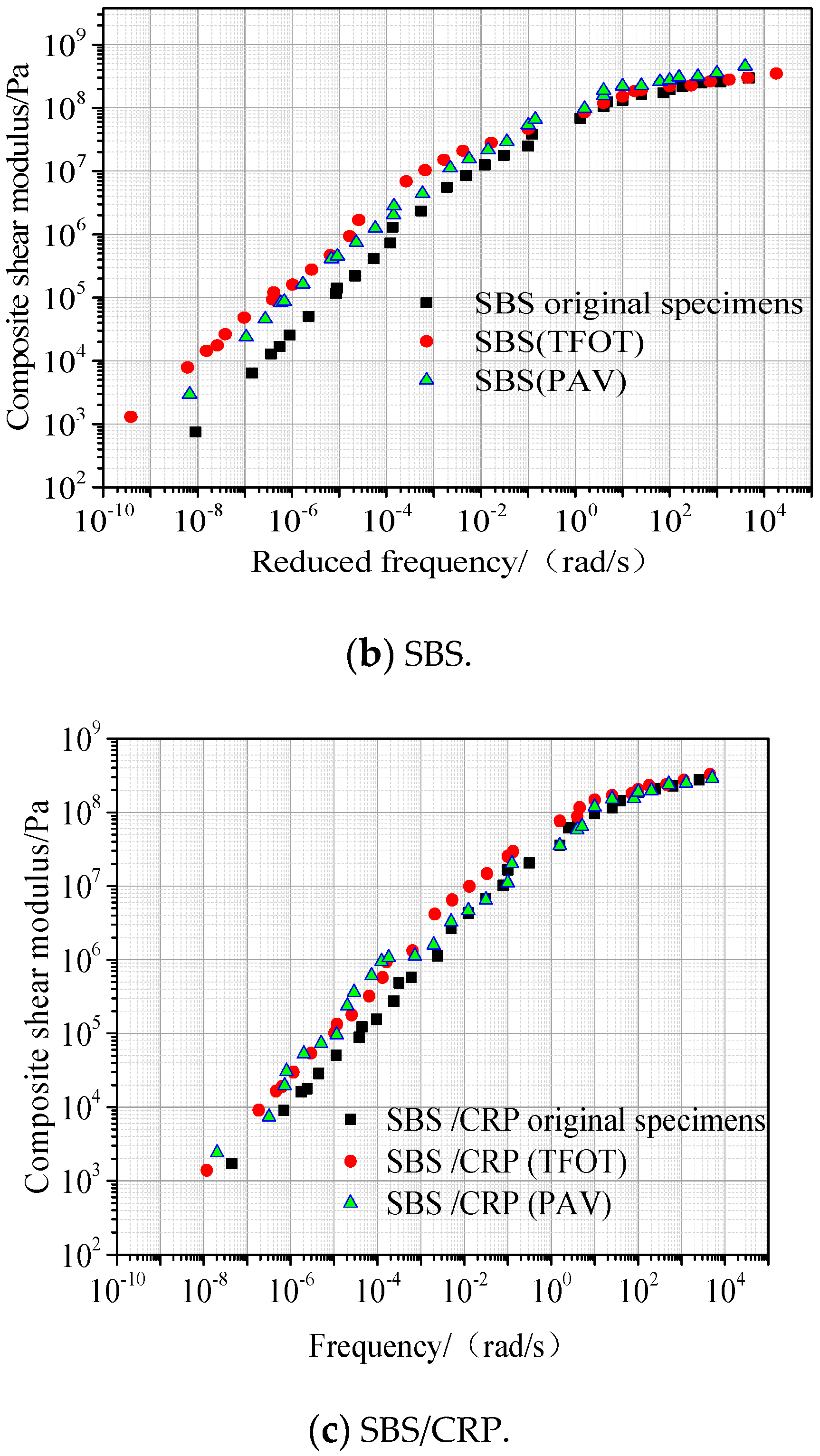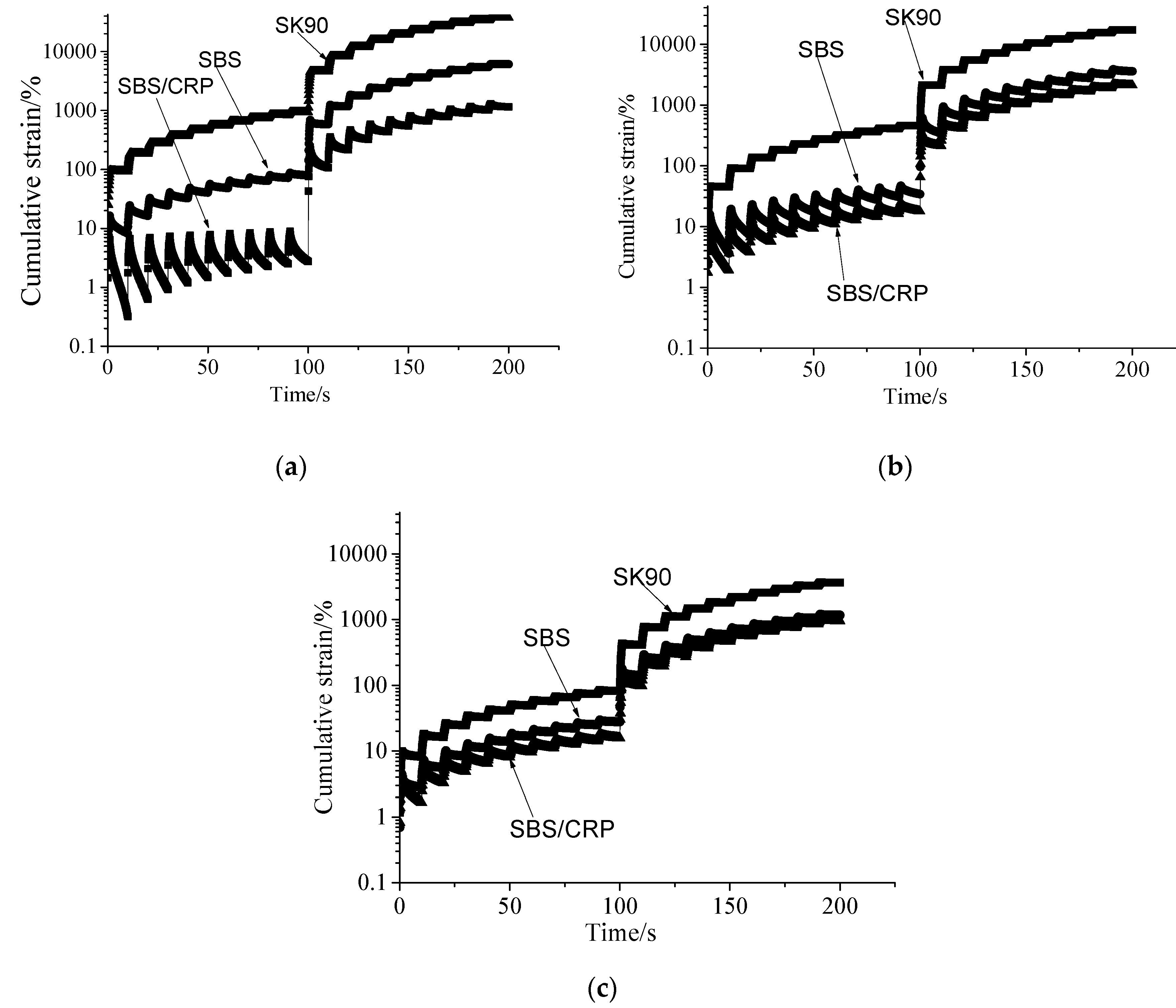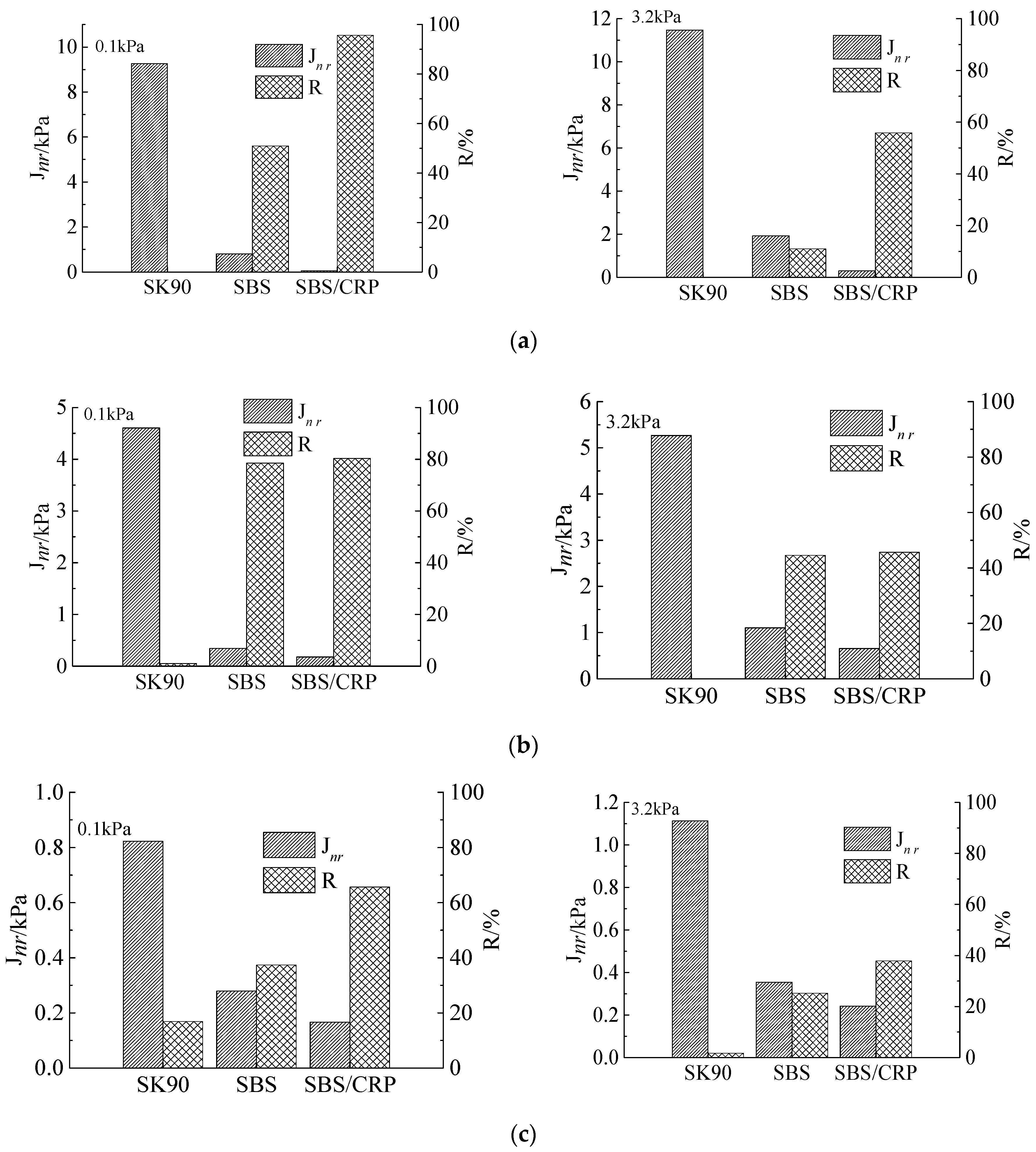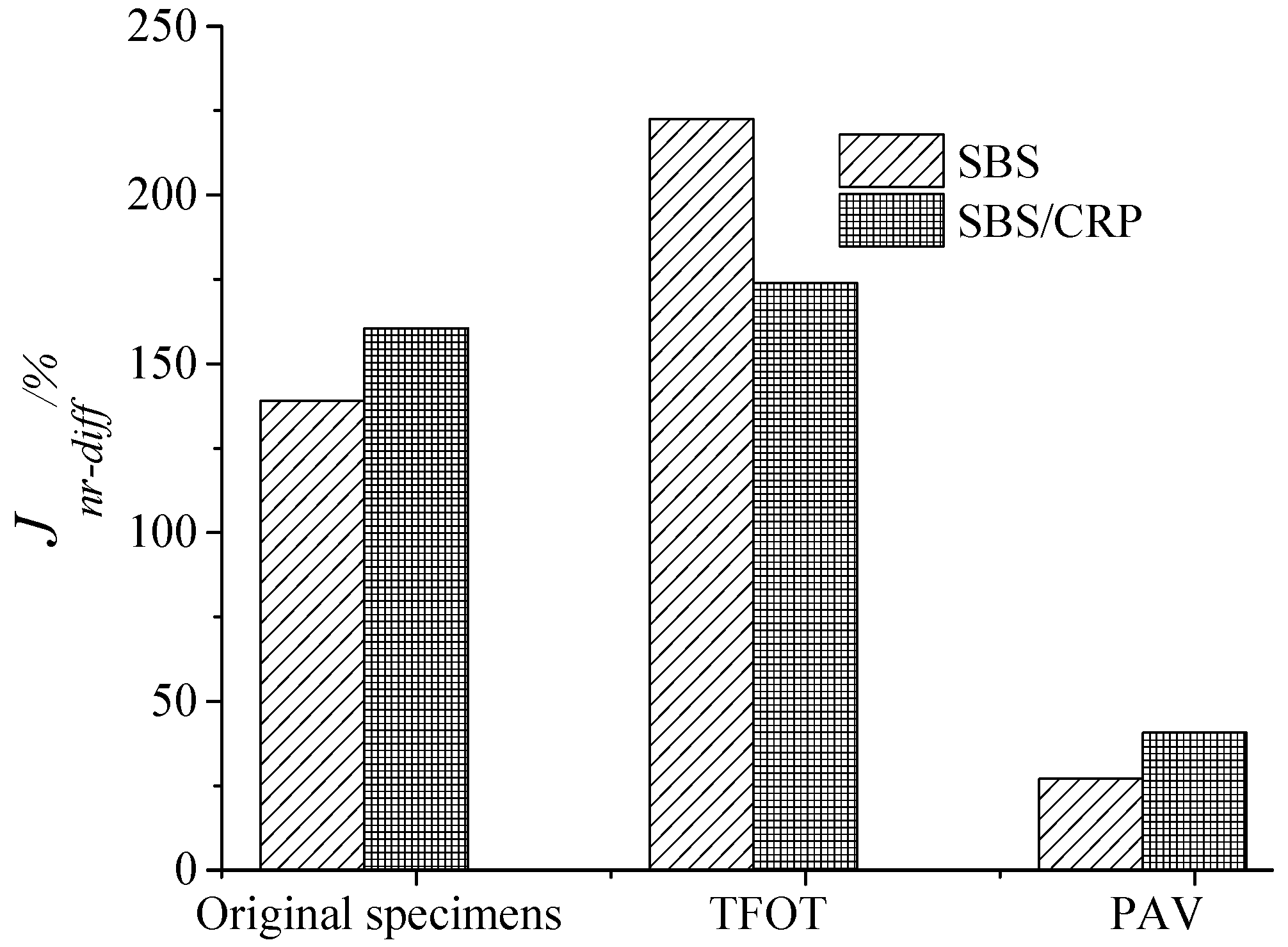1. Introduction
The styrene-butadiene-styrene (SBS) modified asphalt with good high-temperature stability, low-temperature flexibility, aging resistance and fatigue resistance is widely used in road engineering [
1,
2,
3]. However, it has an unsaturated C=C bond so that its low-temperature performance and aging resistance are slightly insufficient in special regions, such as alpine cold plateau regions with strong ultraviolet radiation [
4,
5]. Meanwhile, the demand for SBS modifier is increasing and leads to the increase in price with the development of highway construction [
6]. In addition, it is difficult to recycle the SBS polymer because of the preparation process of modified asphalt, which is not conducive to the sustainable development. At the same time, the crumb rubber powder (CRP) was used more and more popular in the field of road engineering. Some studies concluded that when the rubber powder is mixed with virgin asphalt, cracks appear at the interface, which passivates and consumes energy. The flexibility of virgin asphalt is thus improved. Moreover, elasticity restoration, anti-aging, oxidation resistance and many other advantages have been improved for the original asphalt [
7,
8,
9,
10]. It is widely acknowledged that CRP modified asphalt can improve the high-temperature performance, rutting resistance, and aging resistance of asphalt pavement [
11]. Rasool et al. [
12] analyzed the aging and rheological properties of waste rubber modified asphalt. The results showed that the rubber powder can further enhance the low-temperature performance and anti-aging properties of SBS modified asphalt. Therefore, it is an effective method to combine the crumb rubber powder (CRP) with the SBS as bi-modifier to improve the performance of the SBS modified asphalt binder, reduce the content of SBS in the modified asphalt and promote the recycling of resources.
The aging phenomenon is already a complex process in neat asphalt, and its complexity increases when composite modification is involved. A large number of researchers used laboratory accelerated aging methods such as thin film oven test (TFOT) and pressure aging vessel (PAV) test to simulate the short-term aging and long-term aging, respectively [
13,
14,
15,
16,
17]. Conventional experiments including the penetration test, softening point test, ductility test, Fraass breaking point test and rheological methods including the dynamic shear rheometer (DSR) test, bending beam rheometer (BBR) test and rotational viscosity (RV) test were widely used to evaluate the paving performance and rheological properties of asphalt binders [
18,
19,
20,
21,
22]. In cold regions, asphalt pavement is more prone to cracking because of the aged asphalt binders show the characteristics of brittleness and hardening [
23]. Hence, it is of great importance to have a better understanding of changes in rheological properties and cracking resistance of composite modified asphalt binders after aging. Some studies on the composite modified asphalt binders were conducted. Guo et al. [
24] studied and concluded the best preparation technology of SBS/rubber powder modified asphalt. Li et al. [
25] studied the aging resistance of SBS/CRP-modified asphalt and found that the aging resistance of SBS/CRP-modified asphalt was inferior to that of rubber powder modified asphalt. Tan et al. [
26] used seven kinds of asphalt binders and different modifiers to study the viscoelastic influences on the basis of the hysteresis loop analysis; they found that the rubber powder (or SBS) and aromatic oil significantly improved the elastic energy storage of asphalt. Wang et al. [
27] used the SBS and rubber powder to prepare composite modified asphalt. The swelling temperature for two mixed modifiers was 180 °C, and the swelling time was 1 h; the shearing temperature was 180 °C, and the shearing time was 1 h; the breeding temperature was 170 °C, and the breeding time was 3 h. They also concluded that adding some inorganic or organic powders can play a role of anti-aging, such as rubber powder, nano-TiO
2 and carbon black, etc. However, the previous researchers tend to focus on parts of the performances of the composite modified asphalt binder and are lack of the system evaluation of the rheological properties of SBS/CRP composite modified asphalt from the aspects of high-temperature and low-temperature performances under different aging treatments. Meanwhile, the conditions of these modified asphalts in alpine cold regions are rarely considered [
28,
29,
30].
The objectives of this study are to improve low-temperature cracks and anti-aging ability of asphalt used in alpine cold regions; therefore, SBS and CRP were used to modify the asphalt in this study. Softeners were added to reduce the viscosity of modified asphalt, and various additives were also added to improve the stability and aging resistance of asphalt. In this study, the virgin asphalt, SBS modified asphalt and SBS/CRP-modified asphalt were all treated by the thin film oven test (TFOT) and pressure aging vessel (PAV) aging. Based on the time-temperature equivalent characteristic, frequency and temperature sensitivity were analyzed. The anti-aging, high and low-temperature rheological properties of virgin asphalt, SBS modified asphalt and SBS/CRP modified asphalt were also evaluated.
2. Raw Materials and Test Methods
2.1. Raw Materials
2.1.1. Virgin Asphalt
The SK90 asphalt, which produced SK Group from Seoul, Korea, was used as the virgin asphalt, and technical parameters of its basic performances are shown in
Table 1.
2.1.2. SBS Modifier
The YH791was selected as the SBS modifier, which produced in Sinopec Baling Petrochemical Co., Ltd. (Yueyang, China). The basic performances are shown in
Table 2. The content used for preparing SBS modified asphalt is 4.5% based on the previous study [
31].
2.1.3. Crumb Rubber Powder
The crumb rubber powder was mesh 40–60, and purchased from Changsheng Rubber Factory, Henan, China. Its various indexes are shown in
Table 3. The physical indexes and chemical indexes were tested based on the Chinese specification [
32].
2.1.4. Solubilizer, Anti-Aging Agent and Auxiliary Agent
The solubilizer is an oil-rich in saturated and aromatic components, which produced in Shandong, China. It can make the crumb rubber powder and SBS in asphalt fully swell and reduce the viscosity of asphalt. The contents of solubilizer, anti-aging agent (BC-1 anti rutting agent, which produced in Shandong, China) and auxiliary agent (Sulfur, which produced in Zhengzhou, China) were 7%, 3% and 0.2% by mass of virgin asphalt, respectively [
31].
2.1.5. SBS/CRP Composite Modified Asphalt
The preparation process of SBS/CRP modified asphalt referenced to the literature [
31]. The virgin asphalt was firstly heated and kept at 180 °C. The rubber and anti-aging agent were added into the virgin asphalt and mixed by the shearing machine (The type was A30 and the shearing rate was 5000–25,000 rpm, which produced in Shanghai Ouhe Machinery Equipment Co., Ltd., Shanghai, China) for 30 min; the auxiliary was then added and mixed for 30 min. After that, the SBS was added; they were blended for 25 min and then sheared for 30 min.
2.2. Preparation of Aged Asphalt
The aging process included short-term aging and long-term aging. The short-term aging was conducted by the TFOT to simulate the aging of asphalt in the storage, transportation, mixing and compaction during the construction. The conditions of TFOT for the specimen were 5 h at 163 °C according to the requirements of specification ASTM D-1754 [
37]. The long-term aging was conducted by PAV test to simulate the aging of long-term service performance of asphalt. The conditions of PAV test for the specimen were 20 h at 100 °C, 2.1 MPa based on the ASTM D-6521 [
38].
2.3. DSR Test
In order to evaluate the time-temperature equivalent characteristic of asphalt binder before and after aging, the frequency sweep test was carried out by the dynamic shear rheometer (DSR) (The type was MCR 302 & MCR 102, which produced in Anton Paar company, Ostfildern, Germany) [
39,
40,
41]. The frequency range was 0.1–100rad/s, and the temperature range was −20~70 °C.
2.4. BBR Test
The bending beam rheometer (BBR) (The type was TE-BBR, Canon company, Melville, NY, USA) test was used to evaluate the low-temperature performance of SK90, SBS and SBS/CRP modified asphalt before and after aging. The test temperatures were −12, −18, −24, and −30 °C, respectively. Three parallel tests were used for each condition.
Based on the loading time and original data of deformation of asphalt before and after aging, the relationship (1) between the creep compliance and time was obtained to further characterize the low-temperature rheological properties of modified asphalt. It was fitted based on the Burgers model to obtain the viscoelastic parameters. The comprehensive compliance parameter
J was used to evaluate the low-temperature relaxation characteristics of asphalt binder from the material itself.
where:
v(
t) is the deformation in the middle of the beam, mm;
b is the width of the beam, 12.70 mm ± 0.05 mm;
P is the beam’s fixed load, 980 mN ± 50 mN;
h is the height of beam, 6.35 mm ± 0.05 mm;
l is the span of beam, 102 mm.
Burgers model can be expressed as the relationship (2).
where:
are the parameters of Burgers model.
The Burgers creep equation can be described as the relationship (3):
where:
is creep compliance of asphalt binder;
JE is transient or glassy shear compliance;
is delay compliance.
,
,
.
The comprehensive compliance parameter can characterize the low-temperature performance of asphalt materials.
2.5. MSCR Test
The multiple-stress creep-recovery (MSCR) test was carried out to quantitatively analyze the high-temperature deformation resistance of three asphalts. Two shear stresses, 0.1 and 3.2 kPa, were used, respectively. It has 10 cycles, and each cycle includes a creep stage of loading for 1 s and a recovery stage of unloading for 9 s. The total time for the entire test was 300 s, and the first 100 s was used to condition the specimen; the test temperature is 64 °C.
The single-cycle non-recoverable creep compliance
Jnr was calculated based on the collected strains, which can can be expressed as the relationship (4). The change rate of
Jnr with stress
Jnr-diff and the average strain recovery rate
R were used to evaluate the high-temperature performance of asphalt binder. The calculation method is as follows the relationship (5) and (6):
where:
ε0—initial deformation;
εr—remaining deformation after 9 s recovery;
τ—shear stress;
Jnr—single non-recoverable creep compliance;
Jnr-diff—change rate of non-recoverable creep compliance with stress;
R—recovery rate of single strain;
γr—deformation of recoverable part (including delayed elastic deformation and elastic deformation);
γp—deformation of loading for 1 s.
Jnr(0.1) and Jnr(3.2) were used to represent the average value of non-recoverable creep compliance in 10 cycles under the stresses of 0.1 and 3.2 kPa, respectively. They could reflect the permanent deformation resistance of asphalt under different stresses. The smaller the value, the better the high-temperature performance of asphalt. R(0.1) and R(3.2) represent the average value of deformation recovery rate within 10 cycles under the stresses of 0.1 and 3.2 kPa, respectively.
Based on the above description, the whole test schematic of this study is shown in
Figure 1.
